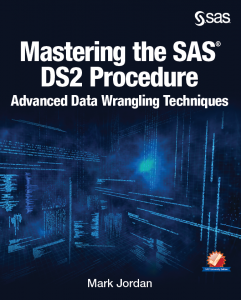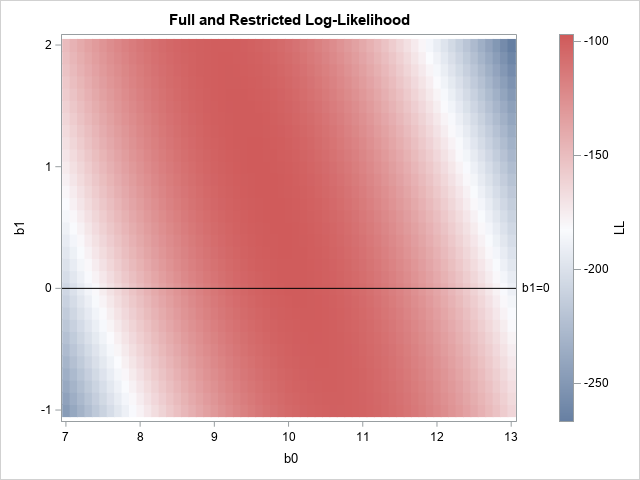 Have you been kicking around ideas for a great SAS book, but don’t know how to get started? Don’t wait another day – connect with the Publish with SAS community and let those amazing folks at SAS Press help you get your project rolling. You won’t regret it! I’m SO excited to have published my first book, “Mastering the SAS® DS2 Procedure: Advanced Data Wrangling Techniques” – the support and encouragement provided by my SAS Press editor, Brenna Leath, and the rest of the SAS Press team was phenomenal. When I had trouble identifying data I could use for the programs in my book, they helped me negotiate a solution. When I suffered the inevitable writer’s block, Brenna counselled, cajoled and inspired me to establish a disciplined schedule that got me moving again. The SAS press team provided several cool cover art selections, and even prepped my manuscript for publishing in both hard copy and e-book format. My Mom and Dad are not geeky, but they sure were beaming when I showed them the finished product!
Have you been kicking around ideas for a great SAS book, but don’t know how to get started? Don’t wait another day – connect with the Publish with SAS community and let those amazing folks at SAS Press help you get your project rolling. You won’t regret it! I’m SO excited to have published my first book, “Mastering the SAS® DS2 Procedure: Advanced Data Wrangling Techniques” – the support and encouragement provided by my SAS Press editor, Brenna Leath, and the rest of the SAS Press team was phenomenal. When I had trouble identifying data I could use for the programs in my book, they helped me negotiate a solution. When I suffered the inevitable writer’s block, Brenna counselled, cajoled and inspired me to establish a disciplined schedule that got me moving again. The SAS press team provided several cool cover art selections, and even prepped my manuscript for publishing in both hard copy and e-book format. My Mom and Dad are not geeky, but they sure were beaming when I showed them the finished product!
Lessons learned as a first-time author:
- Pick a topic in which you have some valuable, interesting or unique experience and for which you have some passion. My experience teaching myself DS2, my budding fascination with the power of this new language, and a deep desire to share more than just snippets in my blog inspired me to want to write a book.
- Having a loose story / theme for the book helps connect the pieces together. I just used my own experiences while learning DS2 as the “story line” for my book.
- Read excerpts from other SAS books to see some of the different writing styles and approaches out there. This will help you get a feel for how you want to approach your book. You can get a free excerpt of many SAS books from the SAS Book Store online. For example, you can download the table of contents and Chapter 2 of my book here for free.
- Pick a style that makes you comfortable. I started out writing in a much more formal / stilted voice than I would have used in normal conversation. Imagining I was explaining the topic to someone face-to-face helped me to write in a more accessible, informal, and conversational style.
- Reach out to other authors for mentoring, inspiration and sometimes even a little commiseration. Ron Cody is one of my all-time favorite SAS authors. Having met him in the course of teaching SAS classes, I decided to ask him about writing a book for SAS. Ron’s encouragement, advice and good humor got me over my initial inertia and launched me on my own road to authorship. In the process I found out that he's not just a great SAS author, he's a really great guy!
- Write a little every day, preferably at the same time. I found that getting up early and working on the book for an hour each day before work was the best time for me. But write every day – even if it’s only a sentence or two.
- Have fun with it! If you’re not having fun, you’re not doing it right.
That’s all for this episode. Until next time, may the SAS be with you!
Mark





7 Comments
Thnx!
options CommentON
SASautos=(SASautos MyComment)
;
libname feedback;
%put "Mark, you are great SASsy author. Well done!";
%include "May the Force be with you always!";
And also with you! :-)
Andrew
I have to echo Mark's comment -- I have yet to read his book. My book is an introduction to DS2; although there are some comparisons to the DATA step, it really focuses on the structure of DS2 and how DS2 helps (forces) you to write better programs. It is my belief that "BIG DATA" are not our problem, rather we face "BIG PROBLEMS". I try t show how the richness of DS2 helps us to deal with these more complex problems -- or as Ashby said, provide Requisite Variety.
I suggest you first buy my book :) , then with all the extra money you make solving problems, buy Mark's
:-)
Hi Mark, would you care to differentiate between 2 recent DS2 publications:
- "Mastering the SAS DS2 Procedure: Advanced Data Wrangling Techniques", by Mark Jordan
- "The DS2 Procedure: SAS Programming Methods at Work", by Peter Eberhardt
(And yes, I'll find the opportunity to ask Peter as well)
I haven't read Peter's book, so can only make my best guess. Peter's book appears to focus on using DS2 methods for object-oriented programming, but touches on many other facets of DS2. My book was intended as a self-study guide to help a competent SAS DATA step/SQL programmer master the new DS2 language. It begins by building on the similarities between traditional DATA step and DS2 DATA programs, then eases into the new syntax and techniques that make DS2 uniquely powerful. I'm sure there are a few things covered in Peter's book not covered in mine, and vice-versa. Each book has it's own unique focus and style. And free excerpts are available for both books from the SAS Book Store to help you make a comparison. Thanks for your interest. May the SAS be with you!